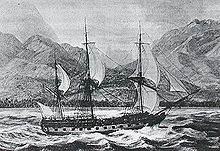La Boudeuse
| frigate | ||
|---|---|---|
| Ship data | ||
| Surname: | La Boudeuse ( French for The Pouting ) | |
| Construction year: | 1766, France | |
| Crew: | 11 officers, 203 ordinary sailors, one historian | |
| Armament: | 26 cannons (8 pounders) | |
| Technical specifications | ||
| Type: | Frigate (timber construction) | |
| Length: | 40 m | |
| Width: | 10.5 m | |
| Draft: | 4.5-5 m | |
| Sails: | 3 masts: 3 square sails each , square and gaff sails on the cross mast | |
| Displacement: | Max. 550 t | |
| Specialty: | technical innovation: hull with copper nails to keep away worms and algae | |
The frigate La Boudeuse was the first French ship to circumnavigate the world. The voyage, led by Louis Antoine de Bougainville, lasted from 1766 to 1769. On the escort ship L'Étoile u. a. the botanist Philibert Commerçon .
The suitability of a frigate as a circumnavigator was critically questioned during the preparations. Typically, robust cargo ships were preferred, which could carry larger amounts of cargo and required fewer personnel. For those in charge of the Boudeuse , however, speed was more important than loading capacity, a view that was confirmed during the voyage.
On November 15, 1766, the voyage started in the port of Nantes . After just three days, the masts of the La Boudeuse broke during a hurricane storm. The commander Louis Antoine de Bougainville recognized the errors in the statics of the ship:
“Our masts are way too high. The shape of the ship itself does not allow enough space for the angle that the shrouds form with the masts. This shortage is made more difficult by our cargo (food), which is deep below the center of gravity of the ship, which means that the mast is in danger even with the slightest lurching. "
As a result, the masts were shortened in Brest and the 12-pounder cannons were exchanged for 8-pounders.
The route ran from France across the Atlantic through the Strait of Magellan into the Pacific Ocean. On April 2, 1768, La Boudeuse landed on the island of Tahiti, which had been discovered by Samuel Wallis a year earlier . Bougainville named Tahiti New Kythera , after the island in Greek mythology on whose beach the goddess of love and beauty Aphrodite rose from the sea. With his travelogue he made the South Seas in Europe a symbol for equality, free love (the women of the islands were extremely revealing) and the bliss of the “ noble savage ”. He supported the revolutionary theory of Jean-Jacques Rousseau and believed that he had found the natural state of man described by him.
From Tahiti the Boudeuse sailed further west to Samoa , to the New Hebrides , to the Great Barrier Reef , then north to the Solomon Islands , to New Britain , to the Moluccas and finally to Batavia for a longer stay, where the ship was serviced and the Team could recover.
In March 1769, after two years and four months, La Boudeuse entered Saint-Malo . Seven sailors had died en route, a relatively small number at that time. The seafaring achievements of Bougainville and his crew were hardly adequately recognized in the stories of seafaring, Jules Verne mentions in the first volume of his anthology The Great Seafarers of the 18th Century the circumnavigation of the Boudeuse . He particularly points out the performance of their captain, Nicolas-Pierre Duclos-Guyot. The classification of this strange journey is still partly controversial and difficult today. But it seems to have been the first circumnavigation of the world in which a woman, Jeanne Baret , was on board - disguised as a man.
literature
- Lutz Bunk: 50 classic ships. From Noah's Ark to Cap Anamur . Gerstenberg Verlag , 2004, ISBN 3-8067-2548-9 .
